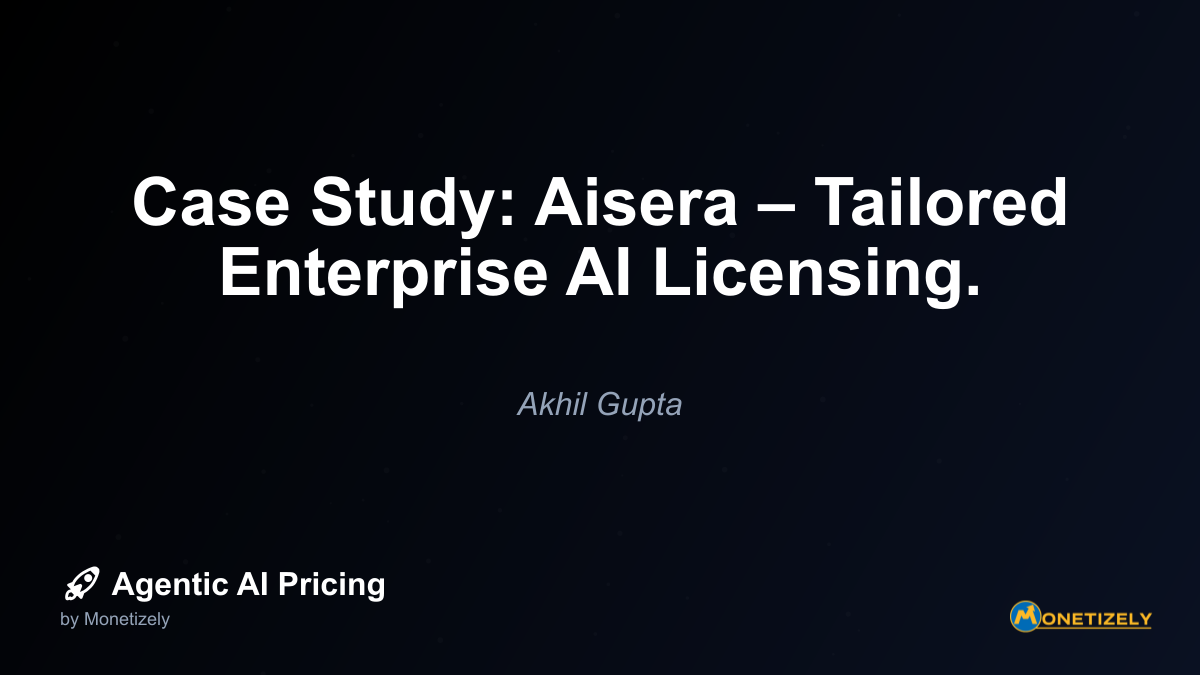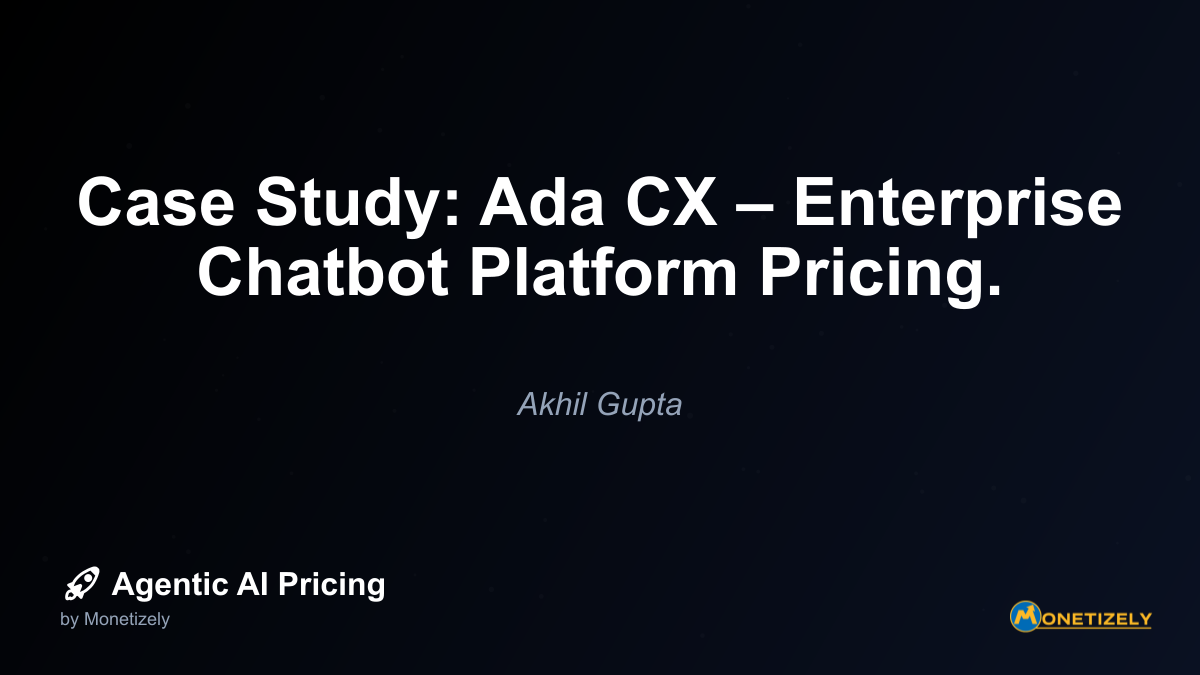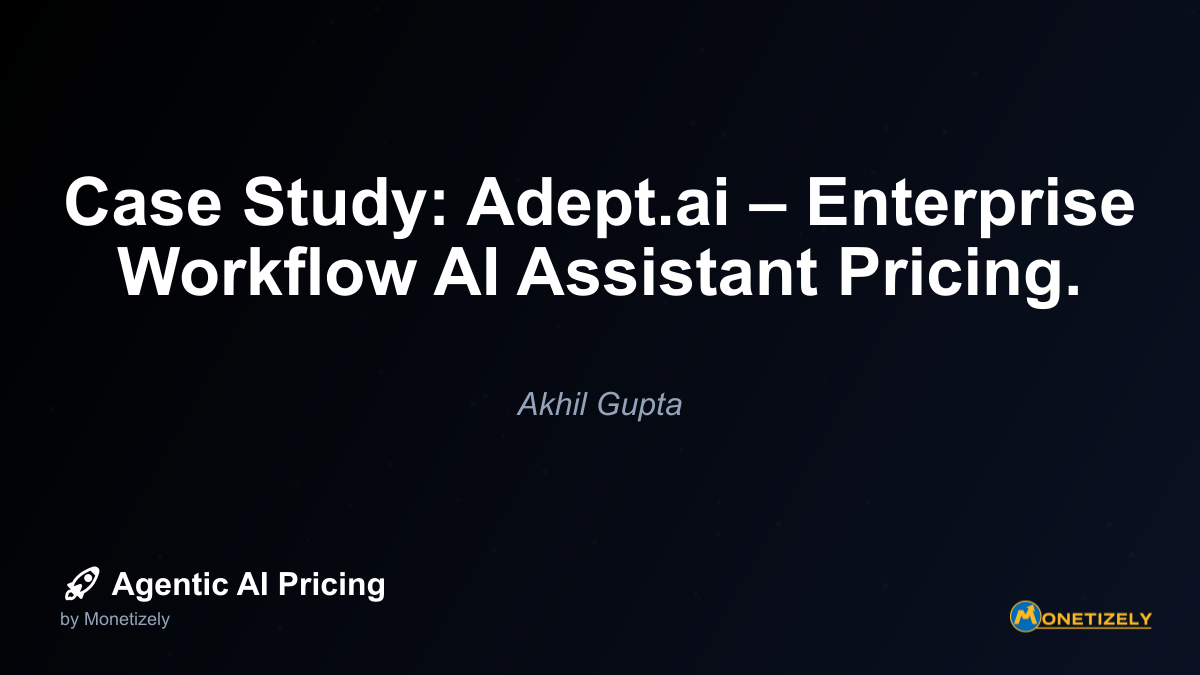· Akhil Gupta · Case Studies · 12 min read
Case Study: Aisera – Tailored Enterprise AI Licensing.
AI and SaaS Pricing Masterclass
Learn the art of strategic pricing directly from industry experts. Our comprehensive course provides frameworks and methodologies for optimizing your pricing strategy in the evolving AI landscape. Earn a professional certification that can be imported directly to your LinkedIn profile.

The key factors that influence Aisera’s pricing structure include:
- Implementation Scope - The number of business domains being automated (IT support, employee services, customer service, etc.)
- User Volume - The total number of end-users who will be interacting with the AI service desk
- Integration Complexity - The number and type of systems requiring integration (ticketing systems, knowledge bases, etc.)
- Customization Requirements - The extent of custom workflows, responses, and automation rules
- Language Support - Requirements for multilingual capabilities across global operations
- Service Level Agreements - Performance guarantees and response time commitments
- Deployment Model - Cloud-based versus on-premises implementation options
This multidimensional approach allows Aisera to align its pricing with the actual value delivered to each enterprise client while ensuring that the company can maintain appropriate profit margins across deployments of varying complexity.
Key Components of Aisera’s Enterprise Licensing Model
Aisera’s licensing model typically consists of several interrelated components that together form a comprehensive commercial agreement. Understanding these components helps potential customers better prepare for the negotiation process.
Annual License Framework
Most Aisera implementations are structured as annual licenses rather than month-to-month subscriptions. This approach reflects the enterprise nature of the solution and the significant implementation effort required to achieve full value. Annual licenses provide several advantages for both parties:
- Predictable Revenue Stream - Aisera can better forecast revenue and invest in platform enhancements
- Implementation Amortization - The substantial upfront implementation costs can be spread across the license term
- Strategic Partnership - Annual commitments foster deeper vendor-client relationships
- Budget Predictability - Enterprises can plan annual IT budgets with greater certainty
Enterprise clients typically expect multi-year agreements with built-in renewal terms and predetermined price escalation clauses to avoid unexpected cost increases.
Usage Tier Structures
Within the annual license framework, Aisera typically implements usage tiers that allow for scalability as client needs evolve. These tiers might include:
- Base Platform License - Core AI service desk functionality with predefined limits
- User Volume Tiers - Incremental pricing based on total supported users
- Transaction Volume Tiers - Additional costs for exceeding predefined interaction thresholds
- Module-Based Add-Ons - Supplemental capabilities for specific business domains
This tiered approach prevents clients from paying for excess capacity they don’t need while providing a clear path for expansion as their requirements grow.
For deeper insights on navigating enterprise AI pricing negotiations, read our comprehensive guide here.Domain Customization and Its Impact on Pricing
One of the most significant pricing variables in Aisera’s model is the number and complexity of business domains being automated. Each domain requires specific knowledge bases, workflow integrations, and AI training to deliver effective automation.
Common Enterprise Domains in Aisera Implementations
Aisera’s platform can automate various business functions, each with its own implementation requirements and pricing implications:
- IT Service Desk - Automating technical support, password resets, system access requests
- HR Service Delivery - Managing benefits inquiries, onboarding processes, policy questions
- Customer Support - Handling product questions, order status inquiries, return processes
- Facilities Management - Coordinating maintenance requests, space reservations, security access
- Finance Operations - Processing expense approvals, budget inquiries, procurement requests
Each additional domain increases implementation complexity and typically requires additional licensing costs. However, there are often economies of scale for multi-domain implementations, as certain platform components can be leveraged across domains.
Domain-Specific Knowledge Base Development
A critical aspect of Aisera’s implementation is developing and maintaining the domain-specific knowledge bases that power the AI’s responses. This process involves:
- Initial Knowledge Extraction - Converting existing documentation into AI-consumable formats
- Workflow Mapping - Identifying and codifying business processes for automation
- Response Training - Developing and refining AI responses to common inquiries
- Continuous Improvement - Ongoing analysis and enhancement of automation effectiveness
The extent of this knowledge base development directly impacts implementation costs and timelines. Organizations with well-documented processes and knowledge management systems typically experience smoother implementations and potentially lower costs.
User-Based Scaling in Enterprise AI Pricing
A core component of Aisera’s pricing model is scaling based on the number of end-users served by the platform. This approach aligns with the value-based pricing philosophy prevalent in enterprise software.
How User Count Affects Pricing Tiers
Aisera typically structures its user-based pricing in tiered bands rather than on a strict per-user basis. For example:
- Tier 1: Up to 1,000 users
- Tier 2: 1,001 to 5,000 users
- Tier 3: 5,001 to 10,000 users
- Tier 4: 10,001 to 25,000 users
- Enterprise Tier: 25,000+ users
This tiered approach offers several advantages over strict per-user pricing:
- Simplified Budgeting - Clearer cost projections for financial planning
- Growth Accommodation - Room for user base expansion without immediate cost increases
- Volume Discounting - Decreasing per-user costs at higher tiers
- Administrative Simplicity - No need for constant user count reconciliation
For global enterprises with tens of thousands of employees, these user tiers allow for predictable costs while delivering the economies of scale that make AI automation financially attractive.
Defining User Types and Access Levels
An important nuance in Aisera’s user-based pricing is the distinction between different user types. Not all users interact with the system in the same way or with the same frequency, and the pricing model reflects this reality:
- Full Users - Employees or customers who regularly interact with the AI service desk
- Occasional Users - Those who might use the system infrequently
- Administrative Users - Staff who configure and manage the AI platform
- API Users - Systems that programmatically interact with the AI service
These distinctions allow for more nuanced pricing that better reflects the actual value delivered to different stakeholder groups within the client organization.
Integration Complexity as a Pricing Variable
The complexity of integrating Aisera’s AI service desk with existing enterprise systems significantly impacts implementation costs and ongoing licensing fees. This factor is particularly important for large organizations with complex IT landscapes.
Common Integration Points in Aisera Deployments
Aisera typically needs to integrate with multiple enterprise systems to deliver full value:
- IT Service Management (ITSM) Platforms - ServiceNow, Jira Service Desk, BMC Remedy
- Customer Relationship Management (CRM) Systems - Salesforce, Microsoft Dynamics
- Human Resource Information Systems (HRIS) - Workday, Oracle HCM, SAP SuccessFactors
- Knowledge Management Systems - Confluence, SharePoint, custom knowledge bases
- Communication Platforms - Microsoft Teams, Slack, enterprise email systems
- Authentication Systems - Active Directory, Okta, other SSO solutions
Each integration requires technical work during implementation and ongoing maintenance to ensure continued functionality as these systems evolve. The number and complexity of these integrations directly influence the overall solution cost.
Integration Approaches and Their Cost Implications
Aisera offers several integration approaches, each with different pricing implications:
- Standard Connectors - Pre-built integrations with common enterprise systems, typically included in base licensing
- Custom API Integrations - Tailored connections to proprietary systems, usually incurring additional costs
- Data Synchronization - Regular data exchange between systems rather than real-time integration
- Manual Processes - Human-in-the-loop approaches for systems without direct integration capabilities
Organizations with standardized IT environments using common enterprise systems typically benefit from lower integration costs compared to those with highly customized or legacy systems requiring bespoke integration work.
Implementation Services and Their Relationship to Licensing
Beyond the core software licensing costs, Aisera’s pricing model includes significant implementation services that are essential for successful deployment. These services are typically priced separately from the software license but are an integral part of the overall solution cost.
Key Implementation Service Components
Aisera’s implementation services typically include:
- Discovery and Planning - Detailed assessment of requirements and implementation strategy
- Knowledge Base Development - Creation and configuration of AI knowledge repositories
- Integration Development - Building connections to enterprise systems
- Workflow Configuration - Setting up automated processes and decision trees
- Testing and Validation - Ensuring accurate AI responses and proper system function
- Training - Educating administrators and end-users on platform capabilities
- Go-Live Support - Hands-on assistance during initial deployment
These services are typically structured as fixed-price engagements based on the implementation scope, though some components may be time-and-materials based for highly customized requirements.
Ongoing Support and Success Services
In addition to implementation services, Aisera’s enterprise model typically includes ongoing support and success services:
- Technical Support - Issue resolution and platform maintenance
- AI Performance Optimization - Continuous improvement of automation accuracy
- Knowledge Base Maintenance - Regular updates to keep information current
- Adoption Services - Programs to drive user engagement and utilization
- Quarterly Business Reviews - Strategic assessment of platform performance and value delivery
These ongoing services are often bundled into the annual license fee, though premium support tiers may be available at additional cost for organizations requiring enhanced service levels or dedicated support resources.
ROI Considerations in Aisera’s Enterprise Pricing Model
A critical aspect of Aisera’s quote-based pricing approach is aligning costs with expected business outcomes and return on investment. This value-based pricing philosophy helps justify the substantial investment in enterprise AI automation.
Key ROI Drivers for AI Service Desk Implementation
Organizations considering Aisera typically evaluate several ROI factors:
- Labor Cost Reduction - Decreased need for Level 1 support personnel
- Improved Resolution Time - Faster answers to common questions and issues
- 24/7 Support Availability - Elimination of off-hours coverage challenges
- Consistent Service Quality - Standardized responses across all interactions
- Scalability Without Linear Cost Growth - Ability to handle volume increases without proportional staffing increases
- Employee Productivity - Reduced time spent on administrative inquiries
- Data-Driven Insights - Better understanding of common issues and process inefficiencies
Aisera’s pricing discussions typically include detailed ROI analysis to demonstrate how the investment will deliver tangible business value over the license term.
Time-to-Value Considerations
An important factor in enterprise AI pricing is the expected timeline for realizing return on investment. Aisera’s model typically addresses this through:
- Phased Implementation - Prioritizing high-value, quick-win use cases for initial deployment
- Value Tracking - Establishing clear metrics to measure business impact
- Success Milestones - Defining specific points at which value should be realized
- Pricing Alignment - Structuring payment schedules that reflect value delivery timelines
This approach helps mitigate the risk of substantial upfront investment by ensuring that organizations begin realizing value early in the implementation process.
Competitive Positioning in the Enterprise AI Service Desk Market
Aisera’s pricing strategy must be understood within the context of the competitive landscape for AI service desk solutions. While maintaining quote-based pricing, Aisera positions itself against both traditional ITSM vendors adding AI capabilities and pure-play AI automation platforms.
Competitive Differentiation Through Pricing Structure
Aisera differentiates its pricing model in several ways:
- Domain Breadth - Pricing that reflects multi-departmental value rather than just IT support
- AI-First Architecture - Investment in true AI capabilities versus rule-based automation
- Integration Ecosystem - Valuing comprehensive enterprise system integration
- Outcome-Based Pricing - Focusing on business results rather than technical features
- Scalability Economics - Delivering increasing ROI as implementation scope expands
These differentiators allow Aisera to justify premium pricing compared to basic chatbot solutions while demonstrating better value than expensive custom AI implementations.
Enterprise AI Market Price Benchmarks
While specific pricing remains quote-based, industry benchmarks suggest that enterprise AI service desk implementations typically involve:
- Annual licensing costs ranging from $100,000 to $1,000,000+ depending on organization size and implementation scope
- Implementation services typically representing 50-100% of first-year licensing costs
- Per-user costs that decrease significantly at scale, often starting at $50-100 per user annually for smaller implementations but dropping to $10-30 per user for large enterprise deployments
- ROI expectations of 200-300% over a three-year period for successful implementations
These benchmarks provide useful context for organizations evaluating Aisera’s quote-based pricing proposals.
Negotiating Aisera’s Enterprise AI Licensing Terms
Given the substantial investment involved in enterprise AI service desk implementation, effective negotiation of licensing terms is critical for both Aisera and its clients. Understanding the flexibility within Aisera’s pricing model can lead to more favorable terms.
Key Negotiation Leverage Points
Organizations negotiating with Aisera typically focus on several key areas:
- Contract Term Length - Committing to longer terms in exchange for more favorable pricing
- Implementation Phasing - Structuring gradual rollouts with corresponding payment schedules
- User Tier Thresholds - Adjusting user band definitions to better match organizational structure
- Success-Based Pricing - Incorporating performance incentives tied to specific outcomes
- Enterprise-Wide Agreements - Negotiating favorable terms for potential expansion to additional business units
- Service Level Guarantees - Securing meaningful performance commitments with financial remedies
- Training and Enablement - Including comprehensive knowledge transfer to reduce ongoing dependence
Effective negotiation requires balancing short-term cost considerations with the long-term strategic value of the AI service desk implementation.
Typical Contract Structure and Terms
Aisera’s enterprise agreements typically include several standard components:
- Master Service Agreement (MSA) - Governing legal terms and conditions
- Order Form - Specific licensing parameters and costs
- Service Level Agreement (SLA) - Performance guarantees and remedies
- Implementation Statement of Work (SOW) - Detailed project plan and deliverables
- Support Terms - Ongoing maintenance and support provisions
Organizations should pay particular attention to terms regarding data ownership, AI training, performance measurement, and renewal conditions, as these can significantly impact long-term value and flexibility.
Future Trends in Enterprise AI Pricing Models
As the enterprise AI market matures, pricing models are evolving to better reflect value delivery and technological capabilities. Understanding these trends provides context for evaluating Aisera’s current pricing approach.
Emerging Enterprise AI Pricing Approaches
Several trends are shaping the future of enterprise AI pricing:
- Outcome-Based Pricing - Tying costs directly to measurable business results
- Consumption-Based Models - Charging based on actual AI usage rather than user counts
- Hybrid Approaches - Combining base subscriptions with variable usage components
- Value-Share Arrangements - Vendors participating in the financial benefits of successful implementations
- Marketplace Ecosystems - Pre-packaged AI solutions with standardized pricing for specific use cases
Aisera’s pricing model will likely evolve to incorporate elements of these approaches while maintaining the customization necessary for complex enterprise deployments.
The Impact of AI Advancement on Pricing Structures
Rapid advancements in AI technology are also influencing pricing models:
- Increased Automation Capability - Expanding the potential value delivered by AI solutions
- Reduced Implementation Complexity - Streamlining deployment through improved tools and methodologies
- Competitive Pressure - More vendors entering the market with various pricing approaches
- Standardization of AI Components - Commoditization of certain AI capabilities affecting value perception
Organizations evaluating Aisera should consider how these technological trends might impact both current pricing and future cost trajectories.
Conclusion: Evaluating Aisera’s Enterprise Pricing Approach
Aisera’s quote-based enterprise pricing model exemplifies the complex nature of AI solution monetization in the enterprise market. Rather than offering simplified, transparent pricing, the company has adopted a sophisticated approach that aligns costs with implementation scope, organizational scale, and expected business outcomes.
For organizations considering Aisera or similar enterprise AI solutions, several key takeaways emerge:
- Expect Customization - One-size-fits-all pricing is rarely appropriate for enterprise AI implementations
- Focus on Value - Evaluate costs in relation to expected business outcomes rather than feature comparisons
- Consider Total Investment - Account for implementation services, ongoing support, and internal resource requirements
- Plan for Evolution - Build flexibility into agreements to accommodate changing requirements and technological advancements
- Leverage Competition - Use market knowledge to ensure competitive pricing while recognizing the value of specialized expertise
As the enterprise AI market continues to mature, we can expect pricing models to evolve toward greater standardization in certain segments while maintaining customization for complex implementations. Organizations that develop sophisticated understanding of these pricing dynamics will be better positioned to make strategic investments in AI automation technologies.
Co-Founder & COO
Akhil is an Engineering leader with over 16+ years of experience in building, managing and scaling web-scale, high throughput enterprise applications and teams. He has worked with and led technology teams at FabAlley, BuildSupply and Healthians. He is a graduate from Delhi College of Engineering and UC Berkeley certified CTO.
Pricing Strategy Audit
Let our experts analyze your current pricing strategy and identify opportunities for improvement. Our data-driven assessment will help you unlock untapped revenue potential and optimize your AI pricing approach.




